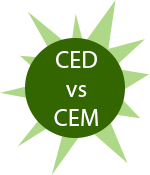Brian & Lori McCulloh
S. 7589 Tainter Hollow Rd. • Viroqua, WI 54665 • Cell (608) 606-3238
Dan & Anne Borgen (612) 618-2567
CED vs CEM

March 5, 2016
Some say that in the long run selection for calving ease direct (CED) eventually results in cattle with lower EPDs for calving ease maternal (CEM). In effect, they are saying that selection for calving ease in the short term (breeding heifers to a high CED bull) will in time produce a cowherd characterized by calving problems (cows with low CEM). There is no published data that supports this opinion. Because it is presented as factual in some circles, we thought it prudent to examine our own data to see if there is any basis for the idea.
The two EPDs in question, CED and CEM were not available until 2005. Prior to that, selection for calving ease had to rely only on a given bull's EPD for birth weight. There was no EPD, no measure for the level of calving ease in the daughters (CEM) of a given bull. Woodhill had been pursuing calving ease for 20 years before the two EPDs were available. If the assertion that CED and CEM are essentially antagonistic (high CED =low CEM) is true, it should be clear in our data.
In fact, the opposite is true. In our 2015 group of heifers, there are 41 with a CED EPD in the top 10% of the breed, ranging from +19 to +12. Of those same 41 females, 39 of them have a CEM also in the top 10% of the breed, ranging from +17 to +12 CEM EPD. The two exceptions had CEM EPDs of +10 (top 25%) and +11 (top 20%), respectively. Further, there is a positive correlation for the two EPDs down through the list. Our bottom half dozen heifers are in the lower 25% of the breed for both CED and for CEM.
Review of the two EPDs in our 2015 bulls, 2014 heifers, and 2013 cows reveals the same positive correlation for CED and CEM. In fact, the calculation of correlation coefficients for the two EPDS yields positive coefficients in the Woodhill herd of .9375 for the 2015 heifers, .9420 for the 2014 heifers, and ,9762 for our 2013 females. The logical explanation is the addition of their own data accounts for the increasingly positive correlation coefficient in the older females.
In other words, calving ease direct and calving ease maternal almost always (95% of the time) occur with the same frequency in our herd.
None of this is surprise here, but it still is a good thing to be challenged to stop and review the long term results of our program. In this particular case, it seems we are on the right track.


